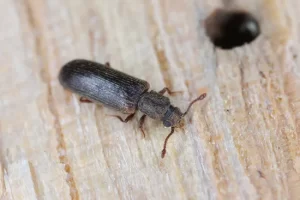Powderpost beetle
Life cycle
 Powderpost beetle larvae spend months or years inside wood while developing, feeding mainly on the starch content. Their presence is only apparent when they emerge as adults, leaving behind pinhole-sized openings, often called “shot holes”. They may also leave piles of powdery frass below. Shot holes normally range in diameter from 1?32 inches (0.79 mm) to 1?8 inches (3.2 mm), depending on the species of beetle.
Powderpost beetle larvae spend months or years inside wood while developing, feeding mainly on the starch content. Their presence is only apparent when they emerge as adults, leaving behind pinhole-sized openings, often called “shot holes”. They may also leave piles of powdery frass below. Shot holes normally range in diameter from 1?32 inches (0.79 mm) to 1?8 inches (3.2 mm), depending on the species of beetle.
If wood conditions are right, female beetles may lay their eggs and re-infest the wood, continuing the cycle for generations.
Target materials
Powderpost beetles feed on deciduous trees, including certain hardwoods or softwoods depending on the species. Some hardwoods are naturally immune if they have low starch content or if their pore diameters are too small for the female beetle’s ovipositor to lay her eggs in.
Wood preservatives can be used to prevent beetle infestation. Common treatments may use boron. Items that can be infested by powderpost beetles include wooden tools or tool handles, frames, furniture, gun stocks, books, toys, bamboo, flooring, and structural timbers.
Management
The following points should aid in discouraging powderpost beetle infestations:
1. Rough-cut lumber should be kiln-dried to kill all stages of the beetle.
2. Uninfested wood which is sanded and varnished will not normally be attacked by the adult beetles because they cannot find crevices in the wood surface into which they would deposit their eggs.
3. Items of value should not be stored in out buildings such as barns and sheds. These buildings are often infested with wood-boring beetles.
4. Infested furniture can be fumigated in a fumigation chamber. Only pest control operators licensed to do fumigations are permitted to purchase and use these materials. Fumigants are highly effective in eliminating all stages of powderpost beetles and leave no residues in or on the wood, but will not provide any protection from future attack.
5. Surface sprays containing borates will prevent newly hatched larvae from entering the wood. However, this technique is not effective on wood which has been varnished, waxed or otherwise sealed from attack by moisture.
6. If you purchase an item with numerous holes (such as an antique), demand that the dealer provide you with a receipt from the company that performed the fumigation.

